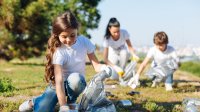Developing SEL Skills With Service Learning
Service learning provides a way for students to grow their social-emotional learning skills while helping their community.
Your content has been saved!
Go to My Saved Content.The conversation around the importance of social and emotional learning (SEL) has seen a resurgence in recent years. The effects of the pandemic, combined with the ongoing trauma that young people are experiencing due to increasing violence, among other factors, have educators quickly searching for solutions to bring SEL practices into their classrooms.
SEL is the process whereby students acquire and apply the knowledge, skills, and attitudes needed to develop healthy identities, manage emotions and achieve personal and collective goals, feel and show empathy for others, establish and maintain supportive relationships, and make responsible and caring decisions. SEL connects students to each other and to the world around them while providing the skills necessary to succeed in school and beyond.
Incorporating SEL into academic courses like English, math, or even physical education can seem impossible. In 2022, nearly two-thirds of educators said that weaving SEL skills into academic subjects was challenging. Service learning provides a research-based solution to meeting both academic and SEL outcomes for students. The National Youth Leadership Council (NYLC) defines service learning as an approach to teaching and learning in which students use academic and civic knowledge and skills to address genuine community needs.
Connection
Service learning is a type of experiential learning that drives students’ academic interests and passions toward addressing real community needs. Students don’t just serve during school hours; rather, they investigate and plan and prepare to take action, all the while reflecting on their experience, and then they end with a demonstration of learning. The process looks different depending on the ages and interests of the students but provides an engaging and dynamic learning experience.
Take, for example, the middle school students in Minneapolis who are majority Somali American. They discovered through investigation that most Minneapolis schools didn’t offer bilingual children’s books (Somali/English), although most Somali American children are growing up in bilingual households. So they wrote, designed, and printed simple picture books that were bilingual and distributed them to schools across the district.
Middle school students in New Orleans investigated the damage caused by repeated hurricanes to their coastal region. Today, they’ve reclaimed the land and offer tours of the coastal restoration project that has become a nature center and their outdoor classroom.
Elementary students in Oklahoma are learning math skills by calculating their body mass indexes anonymously, then aggregating them to assess the relative health of their student population. They did some primary research before they recorded their total walks to schools and elsewhere in an effort to lower their collective BMI. Their project led to state-level legislation and a website to track Oklahomans walking toward a healthier future.
Such high-quality service learning experiences compel students to answer questions like these: What are the true needs in my community? What are the root causes of these needs? How, where, and from whom can I learn more? How can I contribute to a solution?
This connection between students and the community within the service learning experience fosters empathy, improves language and communication skills, and improves the concepts of sharing and teamwork. Students grow more confident and are better prepared for learning. One of the benefits of service learning is the fostering of reciprocal collaboration among students, faculty/staff, community members, community organizations, and educational institutions to fulfill shared objectives and build capacity among all partners.
Reflection
Students not only connect with the community but connect with themselves through reflection. Reflection helps students clarify their values, gain greater self-awareness, and become more open to observed differences rather than reflexively imposing their beliefs on others. For example, one elementary teacher created a Padlet titled, “Things I Would Like to See Changed in My School.” Students generated and posted concerns, which led to sorting the issues into categories, and then they broke into groups with the task of analyzing the data—reflecting more deeply on how they could take action on the issues.
A 2021 report by Civic shared results from two nationally representative surveys of parents and teachers that reported encouraging results: Both parents and teachers endorse a holistic view of education and student success that includes SEL and service learning. They believe SEL and service learning have a reciprocal, mutually reinforcing relationship. These results echo research from the past two decades that asserts that schools must engage the whole child by integrating social, emotional, and academic development with relevant instruction (like service learning).
High-quality implementation, however, remains key to achieving student outcomes. Teachers are encouraged to use the backward planning approach for designing service-learning experiences that provide adequate opportunities to master content standards and SEL outcomes. The K–12 Service Learning Standards for Quality Practice are an essential resource for quality implementation. Published by NYLC in 2008, each of the eight standards—meaningful service, link to curriculum, reflection, diversity, youth voice, partnerships, progress monitoring, and duration and intensity—includes indicators to guide teachers in improving their practice.
The challenges of the current moment require a generation of youth leaders with the knowledge, skills, resilience, and civic dispositions to innovate through times of crisis. SEL and service learning are two practices with clear results in boosting outcomes for students. Student A’Zealya White, from the Satellite Center, St. Charles Parish, Louisiana, says it best: “Service learning helps us talk with people, learn to get things done with a deadline, and prepare for the future. Also, we learn how to identify a problem and solve it.”
